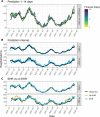The benefit of augmenting open data with clinical data-warehouse EHR for forecasting SARS-CoV-2 hospitalizations in Bordeaux area, France
- PMID: 36380849
- PMCID: PMC9619837
- DOI: 10.1093/jamiaopen/ooac086
The benefit of augmenting open data with clinical data-warehouse EHR for forecasting SARS-CoV-2 hospitalizations in Bordeaux area, France
Abstract
Objective: The aim of this study was to develop an accurate regional forecast algorithm to predict the number of hospitalized patients and to assess the benefit of the Electronic Health Records (EHR) information to perform those predictions.
Materials and methods: Aggregated data from SARS-CoV-2 and weather public database and data warehouse of the Bordeaux hospital were extracted from May 16, 2020 to January 17, 2022. The outcomes were the number of hospitalized patients in the Bordeaux Hospital at 7 and 14 days. We compared the performance of different data sources, feature engineering, and machine learning models.
Results: During the period of 88 weeks, 2561 hospitalizations due to COVID-19 were recorded at the Bordeaux Hospital. The model achieving the best performance was an elastic-net penalized linear regression using all available data with a median relative error at 7 and 14 days of 0.136 [0.063; 0.223] and 0.198 [0.105; 0.302] hospitalizations, respectively. Electronic health records (EHRs) from the hospital data warehouse improved median relative error at 7 and 14 days by 10.9% and 19.8%, respectively. Graphical evaluation showed remaining forecast error was mainly due to delay in slope shift detection.
Discussion: Forecast model showed overall good performance both at 7 and 14 days which were improved by the addition of the data from Bordeaux Hospital data warehouse.
Conclusions: The development of hospital data warehouse might help to get more specific and faster information than traditional surveillance system, which in turn will help to improve epidemic forecasting at a larger and finer scale.
Keywords: SARS-CoV-2; data warehouse; electronic health records; forecasting; machine learning.
© The Author(s) 2022. Published by Oxford University Press on behalf of the American Medical Informatics Association.
Figures



References
-
- World Health Organisation. WHO Coronavirus (COVID-19) Dashboard. 2020. https://covid19.who.int. Accessed September 27, 2021.
Associated data
LinkOut - more resources
Full Text Sources
Other Literature Sources
Miscellaneous
